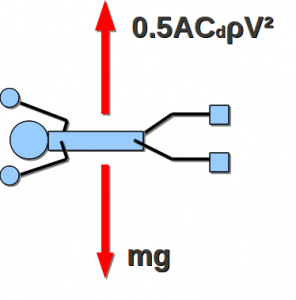Eh..you know, it’s not exactly an equal and opposite reaction… so what do you think?
Kari Byron dropping knowledge on our heads
I have to say, I was a little disappointed by this experiment (22,000-Foot Fall, December 13, 2006). I appreciate that it was very hard to execute, and there are no second chances when dealing with such an elaborate setup, but I would have liked them to apply a slightly more critical eye to themselves. For instance, they spend the whole show assuming they wanted the explosion to go off just as the poor gunner reached the top of the roof.
But why? Maybe the pressure wave would been just the right amount to slow him down without killing him a little further above the “train station”. There are codes out there (I’m thinking BlastX, in particular) that will accurately predict pressure/impulse as a function of distance and explosive type/mass (which I would do, but it’s a restricted code). With this info, you could not only estimate a safe distance to hit the blast wave, but also how much deceleration to expect . Solving the mystery of the airman’s survival needs to start there, since nobody can afford to repeat a bunch of drop tests with 500 lb bombs.
Terminal Velocity
 Not sure how Adam figured out how long it takes to reach terminal velocity (he reported 5.5 seconds) or how high he needed to be to make that happen (500 ft). Typically, terminal velocity simply means that a falling object’s drag force equals the force of gravity:
Not sure how Adam figured out how long it takes to reach terminal velocity (he reported 5.5 seconds) or how high he needed to be to make that happen (500 ft). Typically, terminal velocity simply means that a falling object’s drag force equals the force of gravity:
which is all fine and well, and almost looks like it would help us get to 5.5 seconds (or whatever the time actually is). The only problem is that the non-dimensional drag coefficient, , is not only a function of how the paratrooper falls (I doubt he will naturally assume a typical paratrooper’s position), but also his velocity. And it is a function in unknown ways that can only be determined experimentally (or computationally, I suppose). So we can’t even do an integration without more data or assumptions. I’d be fascinated to know if Adam had something up his sleeve, or was in over his head.

